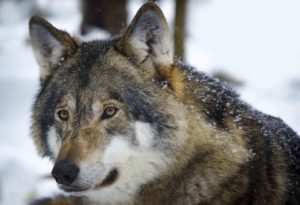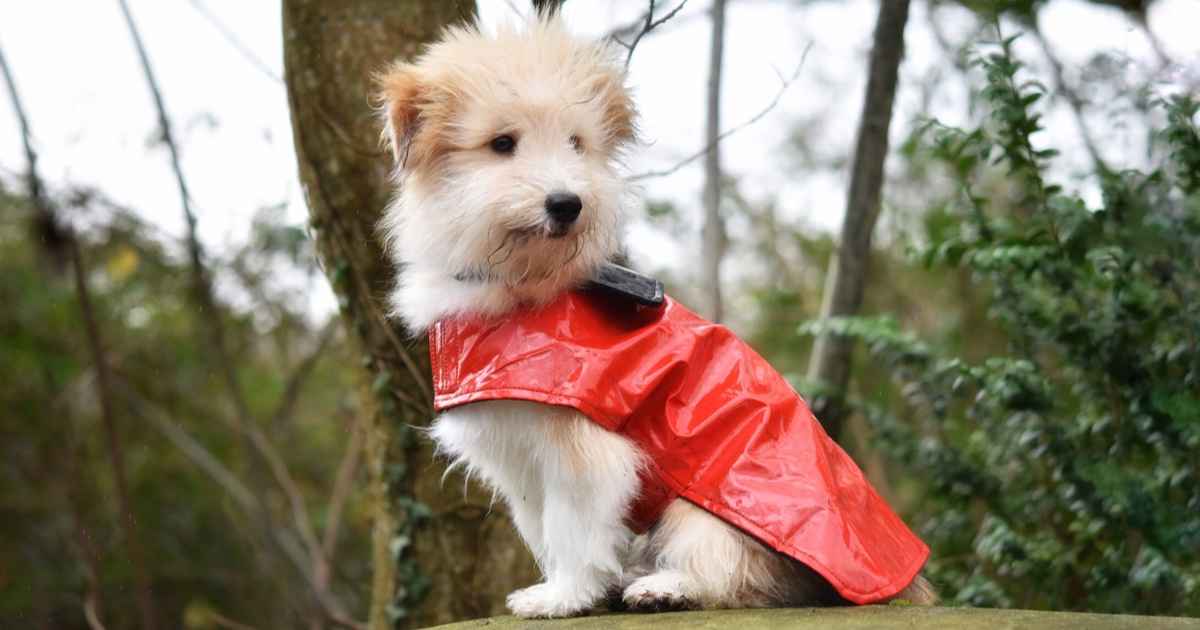Updated November 28, 2020
“They’re dogs; they don’t need coats!”
Have you ever heard people say that? Well, thirty years ago I used to say it too.
I’ve gone from someone who thought dog jackets were silly and pretentious to wanting more dogs to wear them.
Why? Let’s start with that old wolf-versus-dog chestnut.
The Wolf vs The Dog
Are dogs are really only house-wolves? If they were, they certainly wouldn’t need coats. Modern scholars, however, say no. Here are just three reasons why:
- If you try to raise a wolf cub, it will never be a dog.
- Dogs can digest more foods than wolves.
- Dogs have a remarkably different physical appearance. The biggest single change is to their coat.

Here’s a typical wolf. What I want you to see is the way snow can just sit on the coat without melting.
A wolf’s coat is double-layered; rough guard hairs on the outside keep the warm air trapped in the inner downy hairs. It’s so effective that this wolf can be warm at the skin while it’s freezing on the outside.
Now compare this wolf to the dog at the start. Many breeds still have a double coat but that’s not one of them. The critical fact is that most dog coats have been bred based on how they look, not what they do.
The Two-Dog Family
Another sign that some dogs need coats only appears when two dogs live together.
Dogs of different breeds and ages often tolerate cold very differently. One dog may sit right against the heater while another can be outside chewing a bone in the rain. What you notice again and again is that they’re always the same types of dogs.
The fact that I can predict which dogs will do this means there’s something real going on. Instead of saying “that dog’s soft” we might start thinking, “these two dogs feel the cold differently.”
The Anaesthetic Effect
What finally changed my mind for good was watching dogs under anaesthetic. As part of routine monitoring, we measure core body temperature. Needless to say, we always use Bair-Hugger-type warmers and body wraps. When we didn’t, here’s what happened:
- Small dogs dropped faster than big dogs
- Young & old dogs dropped faster than adult dogs
- Single-coated breeds dropped faster than double-coated ones
Put those three together and you can see why Chihuahua breeders used to say that their puppies reacted badly to anaesthetics. Once conscious control is removed, it’s easy to see how some dogs lose heat faster than others. That means they’re likely to be fighting harder when they’re awake.
This is the best evidence we have to construct a guide for dog owners on…
Which Dogs Need Coats
The following dogs are likely to be more comfortable wearing coats in cold weather:
- Puppies and elderly dogs
- Underweight or unwell dogs
- Dogs under 7 kg
- All sizes of dogs with single coats
Single coats are so common that it’s easier for me to tell you which dogs have double coats. There’s a list at the end.
A common mistake I see is letting the coat of a Poodle cross grow out over winter. Not only is the effectiveness of this debatable, but the coat gets matted, the skin gets unhappy and it’s much harder to remove later.
I think these dogs are made better off by clipping year-round and adding a coat in cool weather.
Choosing A Coat
I don’t sell coats but I see them every day and have a fair idea which ones are best.
First, I stress the importance of washability. Wool and oilskins look good, but they’re harder to clean.
Second, the fit is important. If it’s too tight, the dog will resent wearing it. Too loose and it turns into a skirt.
When To Wear A Coat
The best temperature to wear a coat will depend on the dog and the situation. I advise a coat for cold-sensitive breeds when it gets below 14 degrees celsius or 57 Fahrenheit. In southern Australia, that’s most nights in winter.
If a dog will be in the wind or rain, that number should be more like 18 degrees, whereas if the dog can bask in the sun, it could be down to 10.
As the temperature drops further, even breeds considered to be cold-tolerant will eventually need coats. Most importantly, always look at your dog’s body language for signs of being uncomfortably hot or cold. On the right dog you can usually see when they enjoy wearing a coat.
Keeping That Coat On!
What about those dogs that keep taking off their coats? Some of them will just be telling you they feel fine without them. My Loki is one of these; you can always tell when the night was warmer than expected by where his coat isn’t.
Then there are the other dogs that benefit from coats but still take them off or destroy them. It can get quite expensive, not to mention frustrating. My old dog Tinker won’t tolerate anything so all I can do in winter is make sure he’s inside.
That’s the other trick, of course. Even if your dog fits the description above, there are alternatives. Plenty of dogs wouldn’t know what being ‘outside’ feels like. Others, like the dog at the start, might not even need a coat if they’re keeping warm by exercising.
Perhaps all I’m really asking is this: that we throw out the dogma and try to imagine the world from our dogs’ point of view.
Related: Can Dogs Live Outside?
Have something to add? Comments (if open) will appear within 24 hours.
By Andrew Spanner BVSc(Hons) MVetStud, a vet in Adelaide, Australia. Meet his team here.
List Of Common Double-Coated Dog Breeds
- Akita
- Alaskan Husky
- Alaskan Malamute
- Australian Cattle Dog
- Australian Kelpie (some)
- Australian Shepherd
- Australian Terrier
- Bearded Collie
- Belgian Shepherd Malinois
- Belgian Shepherd Tervuren
- Bernese Mountain Dog
- Border Collie (rough and smooth coat)
- Border Terrier
- Bouvier des Flanders
- Briard
- Cairn Terrier
- Chow Chow
- Collie (Rough and Smooth)
- Finnish Lapphund
- Finnish Spitz
- German Shepherd Dog
- German Spitz
- Golden Retriever
- Irish Terrier
- Keeshond
- Labrador Retriever
- Lakeland Terrier
- Newfoundland
- Norfolk Terrier
- Norwegian Elkhound
- Old English Sheepdog
- Parson Russell Terriers
- Polish Lowland Sheep Dog
- Pomeranian
- Portuguese Water Spaniel
- Puli
- Saint Bernard
- Samoyed
- Schnauzer (Miniature)
- Schnauzer (Standard)
- Scottish Terrier
- Shetland Sheepdog
- Shiba Inu
- Siberian Husky
- Skye Terrier
- Swedish Lapphund
- Swedish Vallhund.
- Tibetan Terrier
- Wheaten Terrier
- Wirehaired Fox Terrier
- Welsh Corgi (Pembroke and Cardigan)
- West Highland White Terrier.


You left Great Pyranees and Anatolian Shepherd off of the double coat list.
Thanks. Yes, the key word in the heading is ‘common’. In Australia, both are rare breeds. Outside of the United States, the Great Pyrenees is called the Pyrenean Mountain Dog.
I have a Rottweiler. Can he be shaved in the summer? Here is an outside dog..
Hi Tonya. Check out this page on shaving dogs in summer.
Thanks for this excellent blog. Thank god there are still sensible people around.
Hi, I recently took my long haired chihuahua to the groomers and they shaved him (I didn’t ask for this) I’m just wanting to know if his fur will grow back and how long it will take to look normal?
Thanks
Hi Abbie. Check out this post on hair regrowth after grooming, and also the comments.
I’ve enjoyed reading your articles. Our 6month old Westie is sleeping outside, we live in Tassie. He has a great quality kennel, elevated from the deck and sheltered from the weather. He has a thick foam mattress, a fleece blanket and tonight is wearing a fleece lined jacket for the first time. He is always happy of a morning, and sits in his kennel until he joins us at breakfast time. Is this suitable for a Westie??
Thanks Lou. That sounds perfectly adequate, even for Tasmania!
Why have a dog if you keep it outside. Tasmanian winters are brutal. Poor puppy!
You didn’t mention Cavaliers . Mine has a double coat & will happily wear a dog coat when raining or really bittely cold. Its flanelette lined with material on the outside that repels water. I do oil it from time to time to keep it soft. Have shaved him on occasions but have run into trouble each time. No mare shaves. God provided dogs with their caoats to keep them earm in winter cool in summer
Thank you for the ‘dog coat’ article. We adopted a small white poodle X something and she is tolerant of a coat and helps us put it on her and getting it off. She’s totally inside except for her daily walks. We do two shorter one because she’s an older girl. No idea how old, but her face shows it sometimes. We have four different coats for different environments and weather conditions. She seems to like her walk even when it’s chilly. But she won’t go outside when it’s raining!
Great article as always Andrew
Can I give a really quick plug for an “alternative” – for those dogs that don’t like a coat on (I have one that loves her coat and one that doesn’t and a cat that will not lower himself to wear one) or even those cats that like to be warm and refuse a coat as well, one of the very best warming pads I have EVER come across is the Snugglesafe Microwavable Heat Pad – I even get clients purchasing them for their own beds let alone for their pets.
This pad can be heated up in the microwave for up to 7 minutes (depending on power output) and retains it’s warmth for at least 10 hours!!! (I’ve had one go for 14 hours)
It’s size means you can place it in the bed in such a way that the pet can choose to move away from it it necessary.
I have 4 of them – because my pets need to fight for possession with my MOTH (Man Of The House)
They are not cheap (about $90) but they can be used again and again and again and if used correctly they last for years – and of course the other great thing is it is not permanently plugged in to power
best thing ever
Agreed- we sell very few due to the price but they are great
Thank you, I did have one like this but it has gone to my daughter for her lambs. I haven’tseen them around and don’t want one that requires a power point. Where could I purchase in Adelaide?
Thanks, Julie
We have one on the shelf at Walkerville, but most suppliers should be able to get one in easily.
I love reading your very informative articles. Best bit of advice in this one ? ….”Most importantly, always look at your dog’s body language for signs of being uncomfortably hot or cold”. I have two Min Schnauzers 6 and 7. They are ‘inside’ dogs…. and kept clipped year round. The 7 year old barely tolerates a coat . The 6 year old has been battling with cholangiohepatitis for nearly 18 months and has lost a lot of weight. He really needs the comfort of something to help keep him warm and shows this in how he is holding himself on cooler afternoons and early mornings. He doesn’t wear it during the day and never when on a walk. Of course at night, they are both snuggled into the people beds 😉 .
Great comment!